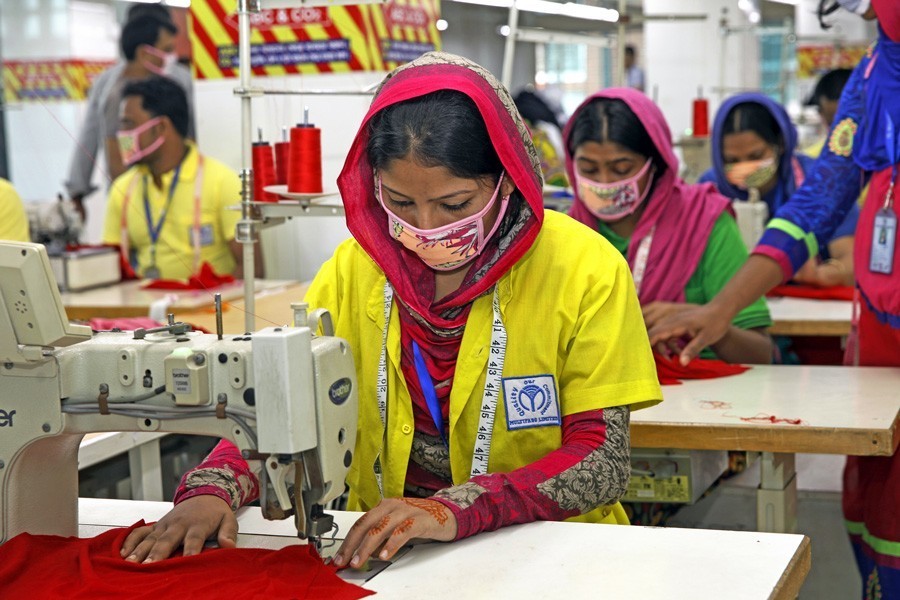A Bangladesh-made polo shirt is sold at around $18.35 in the western markets, while its labour cost is estimated at only $0.54 or 2.95 per cent of the price.
So, buyers have the responsibility to cover up the additional labour cost, caused by the latest wage hike in Bangladesh ready-made garment (RMG) sector.
The statistics and observation were presented at 'Supplier Seminar on Labour Minute Costing and Price Negotiations with Buyers', held at a city hotel on Thursday.
Fair Wear Foundation (FWF) and Bangladesh Knitwear Manufacturers and Exporters Association (BKMEA) jointly organised the seminar. Representatives from 30 factories attended it.
FWF is a non-profit organisation that works with garment brands, factories, trade unions, NGOs and governments to improve working conditions for RMG workers in 11 production countries across Asia, Europe and Africa.
The manufacturing cost of a polo shirt in Bangladesh is $3.50, including fabric, accessories and other overhead cost. Makers sell it at $3.85 with their 10 per cent profit margin, the seminar was informed.
Polo shirt is a medium value added item, and the labour cost is even lower for basic items, which account for majority of garment export earnings.
"Brands accept to increase prices when fabric cost increases or currency fluctuates. But they start bargaining when the workers' minimum wage goes up, making the argument that factories simply need to increase their efficiency," FWF expert Klaus Hohenegger said.
The situation must be seen within the context of Bangladesh, where prices of garment items have been steadily going down year by year, despite rise in production cost, he noted.
"Our view is that it is buyers' responsibility to comply with legal wage requirements. This process starts with transparency, knowing the labour component as part of an FOB (free on board) price," he said.
In this connection, FWF undertook research with suppliers in Bangladesh to assist in the development of a labour-costing tool that could assist suppliers and buyers in determining a factory's cost of one minute of labour, and with that identify the actual increase. It would need to be applied to the manufacturing price to cover the increase in labour cost brought about by the rise in minimum wage.
"We showed factory owners research conducted in Bangladesh after the minimum wage was increased in 2013. It showed that many buyers were not willing to pay more," Mr Hohenegger added.
Unless buyers cover the additional labour costs, the wage increase can work against, rather than in favour of, workers, the seminar was told.
Struggling to cover production costs, factories are reducing their workforce, forcing production staff to work longer hours or set higher production targets, the participants added.
For achieving wage compliance and improving wage, both greater transparency in cost price negotiations between apparel buyers and their suppliers, and a precise determination of the labour component must take place, FWF officials said.
"The FWF labour minute calculator offers the much-needed transparency. It shows how much the price of a garment would need to go up in order to give factories the required financial room to ensure payment of at least the legal minimum wage, all other things being equal," said another expert of FWF Koen Oosterom.
The FWF tool also makes it possible to calculate the labour cost per product based on a higher wage level, and the calculation varies from factory to factory and from item to item.
Fazlee Shamim Ehsan, vice-president of BKMEA, pointed out that in a margin-driven industry, buyers are often unwilling to shoulder the higher costs of compliance with new legal wage requirements, while at the same time suppliers resist open costing.
Suppliers are at times reluctant to provide a detailed breakdown of costs, thinking that it will be used against them, and they will be pressured to lower prices even further.
"Garment prices are highly sensitive, particularly in the fiercely competitive and fast-moving fashion sector. But a detailed examination shows that the labour element accounts for a relatively small share of the price that consumers pay," he added.
"The cost of labour is just a fraction of the retail price, often not more than 1-2 per cent," Mr Oosterom said.
Making this transparent is important, as it shows that it is entirely possible to increase wages without affecting the 'marketability' of the garments concerned, he added.
"There is common ground for brands, factories and trade unions," said Mr Hohenegger.
He expressed hope that the growing interest in labour cost transparency might lead to an agreed sector-wise approach to due diligence on wage compliance.


